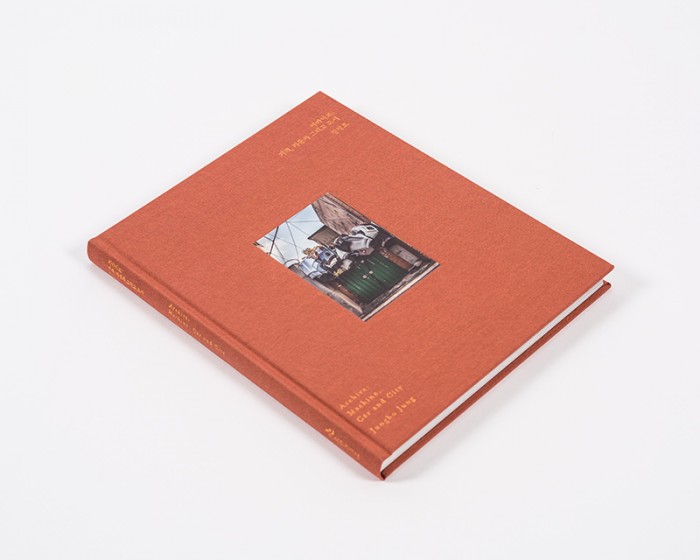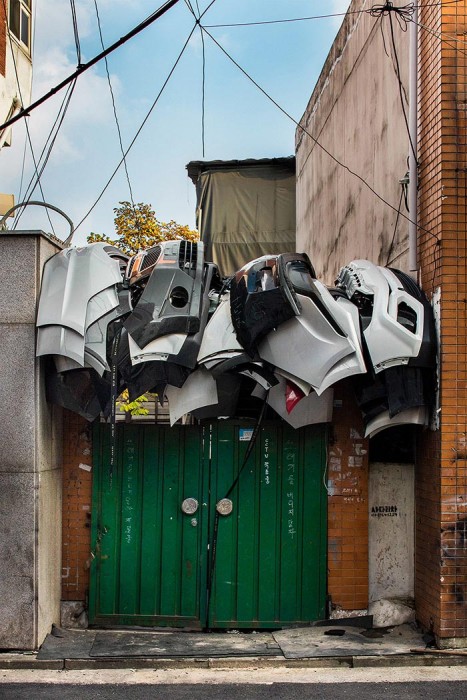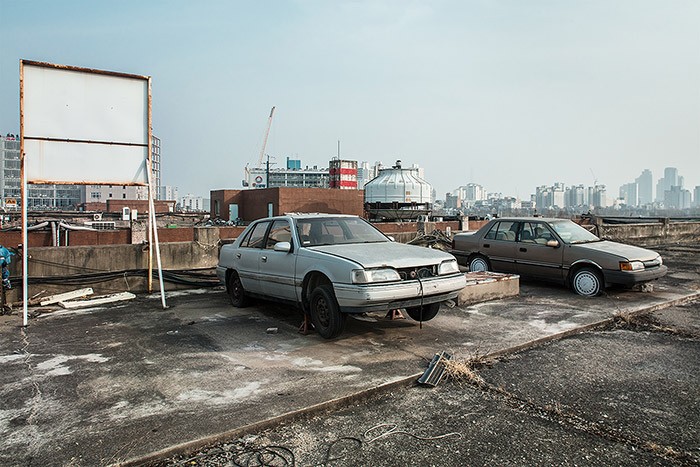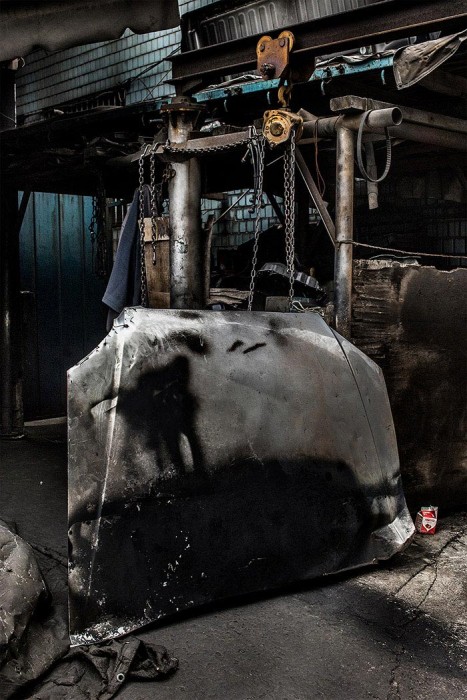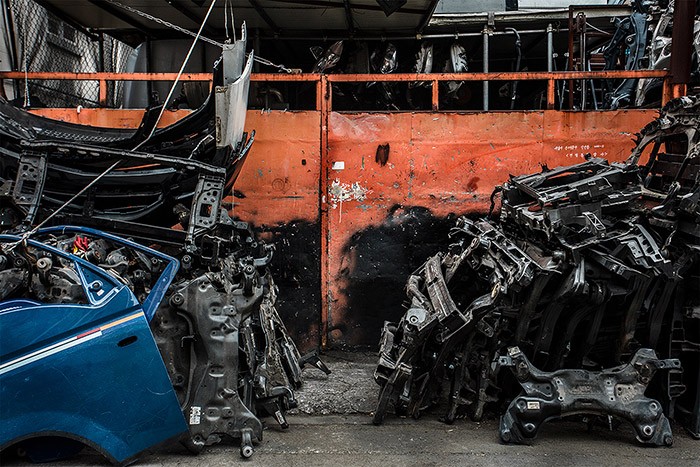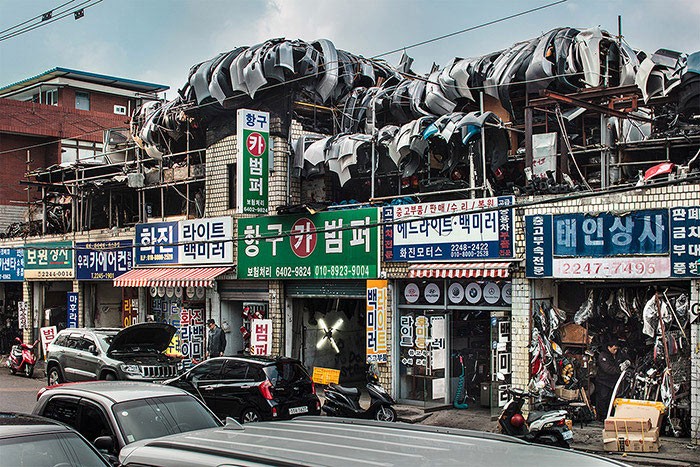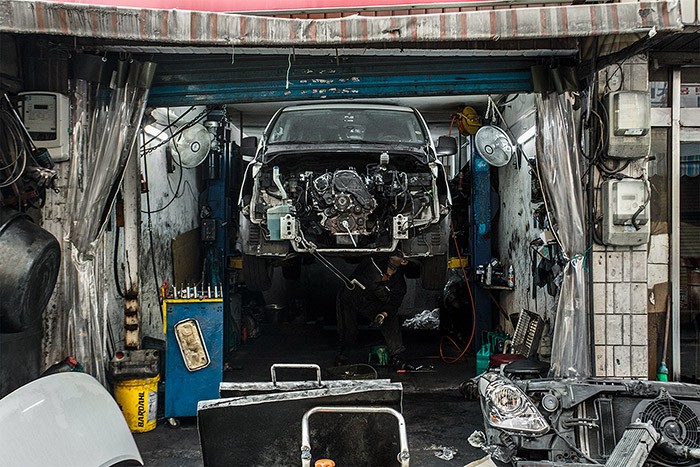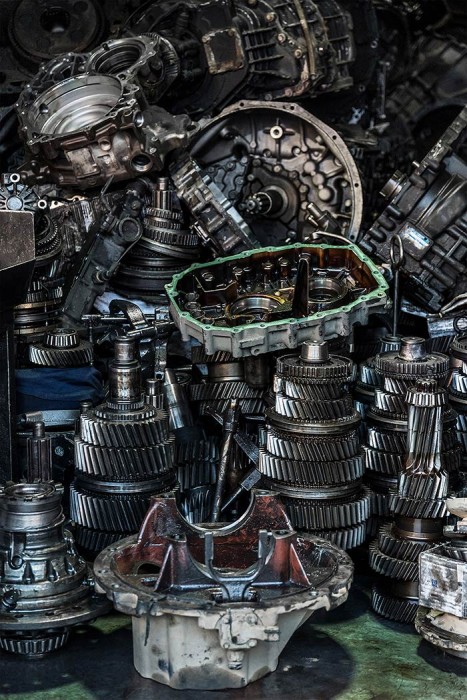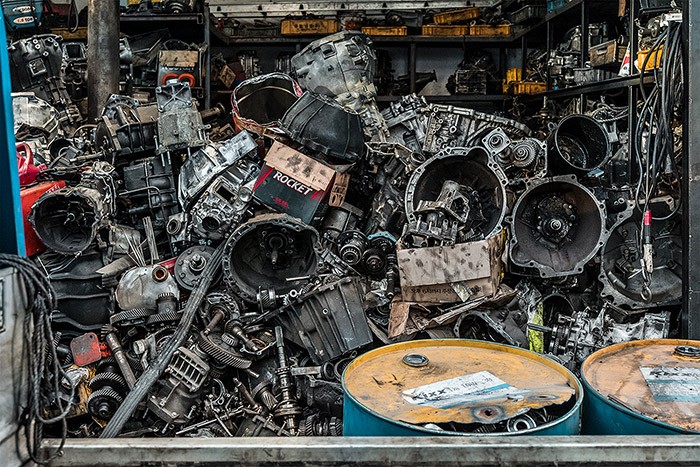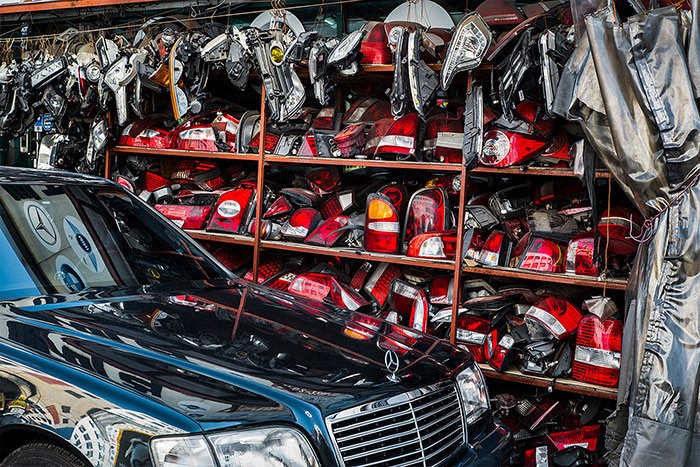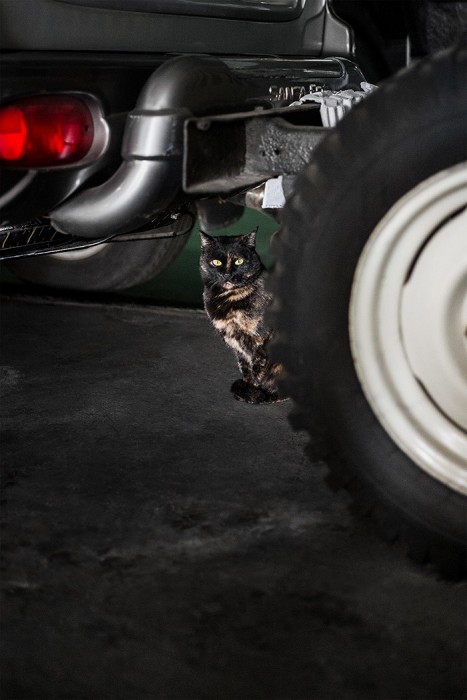*์์นด์ด๋ธ: ๊ธฐ๊ณ, ์๋์ฐจ ๊ทธ๋ฆฌ๊ณ ๋์ (Archive: Machine, Car and City), 2019
์์ธ์ ๋์์ฌ์ํ์ฑํ๊ณผ์ ์ปค๋ฏธ์
์ํฌ๋ก ์ ์
This Works Support fund for the project, Seoul Metropolitan Government
์์
๋
ธํธ <์์นด์ด๋ธ:๊ธฐ๊ณ, ์๋์ฐจ ๊ทธ๋ฆฌ๊ณ ๋์>
๋์๋ ๋ณํํ๋ค. ์์ฑ๊ณผ ์๋ฉธ์ ๋์๋ผ ํด๋ ๋น๊ปด๊ฐ ์ ์๋ ์ด๋ช
์ด์ง๋ง ๋๋ฌด ๋นจ๋ฆฌ ๋ณํํ๋ค๋ ๊ฒ์ด, ๊ธ์ธ ์ฌ๋ผ์ ธ ๋ฒ๋ฆฐ๋ค๋ ๊ฒ์ด ๋ฌธ์ ๋ค. 40๋
๊ฐ ์ค๊ณ ์๋์ฐจ์ ๋ฉ์นด์๋ ์ด๊ณณ ์ฅ์ํ๋ ํ์ ์์ด ์ฌ๋ผ์ง๊น ๋ด ๋๋ ค์ ๋ค. ์ฐ์ฐํ ๊ธฐํ์ ์์ธ์์ ๋์์ผ๋ก ์ด๊ณณ์ ์ฌ์ง์ผ๋ก ๊ธฐ๋กํ๋ค.
์ฅ์ํ ์ค๊ณ ์ฐจ ๋งค๋งค์๊ฐ๋ ํ๊ตญ ์ค๊ณ ์ฐจ ์์ฅ์ ์ฐ์ฆ์ธ์ด์๋ค. ๋์ผ๋ก ๊ฐ๋ ์ฑ์ด ๊ฐ๋ฐฉ์ ๋ฉ ์๋๋ค์ด ์ค์ ์์ ๊ธฐ๋ค๋ ธ๋ค๋, ์ง์์ด ์์ญ ๋ช
์ด์๋ค๋ ์ฌ์ฅ๋์ ํ๋ คํ ์ ์ถ์ต์ ์ฌ๋ฌด์ค์ ๊ธ๋น ์์ฅ์ฒ๋ผ ์ก์ ์์ ๋ฐ์ ๋ ์ฑ ๊ณผ๊ฑฐ์ ์๊ด์ด ๋์ด๋ฒ๋ ธ๋ค. ๋ชฉ์ฒญ ๋์ธ ํธ๊ฐ๊พผ ์์ ์จ๋, ๋ฐ ๋๋ ํ ์๋ ์งํ ์๋น๊ฐ์ ์ฃผ์ธ์์ฃผ๋จธ๋๋ ์ด์ ๋ ๋์ด๊ฐ ๋ค์๋ค. ์งํ ๊ตฌ์์ ๊ณ ์์ด๋ค์ด ๊ธด ํํ์ ํ๊ณ ์๋ค.
์ค๊ณ ๋ถํ ๊ฑฐ๋ฆฌ๋ฅผ ๊ฑธ์๋ค. ๊ฐ์ฅ ๋จผ์ ๋์ ๋๋ ๊ฑด ์ค๊ณ ์ฐจ์ ๋ถ์ํ์ด์๋ค. ์ก์คํ๊ณ ๊ธฐ๋ฆ๋ ๋ฌป์ ๋ฉ์ด๋ฆฌ๋ ๋ง์น ์ธ์ฒด์ ๋๋ฌ๋ ์ฅ๊ธฐ ๊ฐ์ ๋ณด์๋ค. ๊ธฐ๊ณ๊ณต๋ค์ ๋ฉ์ค๋ฅผ ๋ ์์ฌ์ฒ๋ผ ๊ธฐ๊ณ๋ฅผ ์์ ํ๋ ๋ฏํ๋ค. ์๋ฆฌ๋ฅผ ๋ง์น๊ณ ํ์ํ ๋ถํ๋ค์ ์ฃผ๋ณ ๊ณต๊ฐ ์์ ์ ์ ํ, ์ค๋ ์๊ฐ ๊ณต๋ค์ธ ๋ํ์ฒ๋ผ ์์ฌ๊ฐ๋ค.
๋ถํ์๊ฐ ์์์๋ ํ๋ฐฐ์ฐจ์ ์คํ ๋ฐ์ด๊ฐ ์ด ํ ์์ด ์์ง์ธ๋ค. ๋ฐ์ค๊ฐ ๊ณณ๊ณณ์ ์์ฌ ์๋ค. ๋ถํ์ ์์
ํด๊ฐ๋ ค๋ ์๋์ธ๋ค๊ณผ ์ํ๋ฆฌ์นด ์ฌ๋๋ค๋ ๋ณด์ธ๋ค. ๊ทธ ๊ฐ์ด๋ฐ ํ๋์ ํ์ ์ค์ ์ด ๋๋ณด์ด๋ ๋ถํ์๊ฐ๊ฐ ์๋ค. ๋ถํ์๊ฐ๋ฅผ ๋๋ฌ์ธ๊ณ ๋ณํ์ฒ๋ผ ์ ๋ช
๊ฑด์ค์ฌ ์ํํธ๊ฐ ๋ค์ด์ ๋ชจ์ต์ ๊ฝค๋ ์์์ ์ด๋ค. ๋ถํ์๊ฐ ์ผ๋๊ฐ ๋ฏธ๊ด๊ณผ ํ๊ฒฝ์ ํด์น๊ณ ๊ตํต ํผ์ก์ ์ ๋ฐํ๋ค๋ ์ด์ ๋ก ์ํํธ ์ธก์ ๋ฏผ์์ด ์ฆ๋ค๊ณ ํ๋ ์์ธํ ๋ฟ์ด๋ค.
์ง์ญ์๋ ์์ฐ์ค๋ ๊ทธ๊ณณ์ ์ญ์ฌ๊ฐ ์ค๋ฉฐ ์๋ค. ๊ทธ๋ ๊ธฐ์ ์ฐ๋ฆฌ๊ฐ ์ฅ์ํ์์ ๋ณด๋ ๊ฑด๋ฌผ, ๊ฑฐ๋ฆฌ ๊ณณ๊ณณ์ ๋ชจ์ต์ ์ค์ง ์ด๊ณณ์์๋ง ๋ณผ ์ ์๋ ํ๊ฒฝ์ด๋ค. ๋คํํ๋ ์์ง๊น์ง๋ ์ด ์ง์ญ ์ฌ๋๋ค์ด ์์ญ ๋
๋์ ์ผํ๋ฉฐ ์์ ์ฌ๋ฆฐ ๊ธฐ์ต๋ค์ด ๊ทธ๋ค์ ์ฃผ๋ณ์ ๊ทธ๋๋ก ๋จ์ ์๋ค. ์์ผ๋ก ๋ช ๋
๋ค ๋ค๊ฐ์ฌ ์ ๋น ์ฌ์
์ผ๋ก ์ธํด ๋์๊ฐ ์ด๋ป๊ฒ ๋ณํ๋ ์ง๋ ์ง์ผ๋ณผ ์ผ์ด๋ค.
โ์ฅ์ํ์ ์์๋์?โ, ์ ํ, ๋ฏธ์ ๋นํ, ์ธํ๋๊ต์
โ์ฅ์ํ์ ์์๋์?โ
โ์ค๋๋ ์ฐ๋ฆฌ๋ ์์ธ์ ์ญ์ฌ์ ๋ฌธํ๋ฅผ ์ด์ผ๊ธฐํ ๋ ์ฃผ๋ก ์ฌ๋๋ฌธ ์ํ์ ์ญ์ฌ์ ๋ฌธํ ์ ์ ์๋ง ๊ด์ฌ์ ๊ธฐ์ธ์ฌ ์์ต๋๋ค. ๊ทธ๋์ ๋๋ก๋ ์ค๋๋ ์์ธ์ ํ์ ์ ์ผ๋ก ํธ์
๋์๋ ์์ฃผ, ๊ด์ฃผ, ์ํฅ, ์์ฒ, ๊นํฌ, ๊ณ ์์ ์ญ์ฌ๋ ์ฃผ๋ณ ์ง์ญ์ ์ญ์ฌ๊ฐ ๋์ด๋ฒ๋ฆฌ๊ณค ํฉ๋๋ค. ์ด๋ฌํ ์ํฉ์ ์ฐ๋ฆฌ๊ฐ ์ฐ๋ฆฌ์ ํฐ์ ์ธ ์์ธ์ ์ด์ฒด์ ์ผ๋ก ์กฐ๋งํ๊ธฐ ์ด๋ ต๊ฒ ๋ง๋ค๊ธฐ๋ ํฉ๋๋ค.โ
โ ๊น์๋, ใ์์ธ ์ ์ธใ, 25์ชฝ
์ฅ์ํ์ ํ๋ฃจ
์ธํฐ๋ท์ผ๋ก โ์ฅ์ํโ์ ๊ฒ์ํ๋ฉด ๊ฐ์ฅ ๋จผ์ ์์ธ์ ๋์ฌ์ฌ์ํ์ฑํ์ง์ญ ๊ด๋ จ ๊ธฐ์ฌ๊ฐ ๋ฌ๋ค. ๋ด์ฉ์ ์ดํด๋ณด๋ฉด 1979๋
์ค๊ณ ์๋์ฐจ๋งค๋งค๋จ์ง ์ค๊ณต ์ดํ 40๋
๋์ ๋ํ๋ ๋ด์ธ๋ถ์ ์์ธ์ ๊ฐ์ ํ๊ณ ์ฐ์
์ ์ฌ๋ ฅ์ ํ์ฑํํ์ฌ ์ฃผ๊ฑฐ์ ์ฐ์
์ด ๋ณตํฉ์ ์ผ๋ก ์์ํ ์ ์๋ ์ง์ญ์ผ๋ก์ ๋ณ์ ์ ๊พํ๋ค๋ ๊ฒ ์์ง๋ค. ๋๊ฐ์ ๊ธฐ์ฌ๋ ํ์ฌ ์ค๊ณ ์๋์ฐจ์์ฅ์ด ์ฒํ ๋ก์ ๋ฌผ๋ฆฌ์ ์ธํ๋ผ, ์จ๋ผ์ธ์์ฅ ํ์ฑํ๋ก ์ธํ ํ๊ฒฝ ๋ณํ๋ฅผ ๊ทน๋ณตํ ์๋์ฐจ์ฐ์
๋ณตํฉ๋จ์ง ์ค๋ฆฝ์ ๋ค๋ฃจ๊ณ ์๋ค. ๊ฐ์๊ธฐ ์ฅ์ํ์ ๊ณผ๊ฑฐ๊ฐ ๊ถ๊ธํด์ก๋ค. ์๋ ์ด๊ณณ์ ์กฐ์ ์๋ ๊ตฐ๋ง ๋ฐฉ๋ชฉ์ฅ์ด์ ๊ธฐ๋งํ๋ จ์ฅ์ด์๋ โ๋ง์ฅ์๋ฒโ์ด ์ ๋๊ฐ ๋์ด ์ฅํํ, ์ฅํ๋ฒ์ด๋ผ ๋ถ๋ฆฌ๊ฒ ๋์๋ค๊ณ ํ๋ค. ํ๋ฐ ๊ฐํ๊ธฐ ์ฅํํ์ ์ ๋
์ฆ์ ์ค๋์ฒ ๋ฒ๋์ ๋ง๊ณ ์ ๋์ง๋ก ๊ฐ๊ฐ๋์๋ค. 1975๋
ํ ์ง์ ๋ฆฌ๊ตฌํ์ฌ์
์ ์ค์ํ ํ, ์์ธ์ ์กฐ๋ก์ ๋ฐ๋ผ ์ฃผ๋ณ์ ์ค๊ณก๋, ๋ฅ๋, ๊ตฐ์๋์ ์ผ๋ถ๋ฅผ ํฉํ์ฌ ์๋ก์ด ํ์ ์ง์ญ์ธ ์ฅ์๋์ด ์ ์ค๋๊ณ ๊ธฐ์กด ์ฉ๋๋์ด ๋ต์ญ๋ฆฌ๋ ์ผ๋ถ์ ํฉ์ณ์ง๋ฉฐ ์ฉ๋ต๋์ผ๋ก ์ฌํธ๋์๋ค. ํํธ ์ฅ์ํ ์ผ๋๋ ์ด๋ฏธ 1964๋
๊ตฐ์ฌ์ ๊ถ ์์ ์์ธ๋์๊ธฐ๋ณธ๊ณํ์ ๋ฐ๋ผ ์ค๊ณต์
์ง์ญ์ผ๋ก ์ง์ ๋์๋ค๊ณ ํ๋ค. ์ฆ ์ฅ์ํ์ ์์ธ ๋์ฌ ์ฐ์
๊ฐ๋ฐ๊ณํ์ ์ํ์ฌ ํ์ฑ๋์๊ณ ๊ทธ๋ ๊ฒ ํ์ฌ์ ์ด๋ฅด๋ ๋ค.
๋ด๊ฒ ์ฅ์๋์ ๋ํ ์์ ์นํ ๋๊ธฐ ๋๋๊ฐ ์ด๋ ๋๋ค๋ก ๊ธฐ์ต๋๋ค. ์์ธ์์ ๋จ ํ ๋ฒ๋ ๋ฐฉ๋ฌธํด ๋ณธ ์ ์ด ์๋ ์ง์ญ ์ค ํ ๊ณณ์ด ๋ฐ๋ก ์ฌ๊ธฐ ์ฅ์๋์ด๋ค. ๋น๋ก ๋ฐฉ๋ฌธํ ์ ์ด ์๋ค ํ์ฌ๋ ์์ค, ์ํ๋ ๋๋ผ๋ง๋ฅผ ํตํ ๊ฐ์ ๊ฒฝํ์ด๋ผ๋ ์์ ๋ฒํ๋ฐ, ์ ํ ๊ธฐ์ต์ด ์๋ ๊ฑธ ๋ณด๋ฉด ์ด ์ง์ญ์ ๋ฌธํ์ ๋ฒ์ฃผ์์๋ ๊ฐ์ฅ์๋ฆฌ์ ์์นํ ๊ฒ์ด ๋ถ๋ช
ํ๋ค. ๋ด๊ฐ ์ฌ๊ธฐ๋ฅผ ์ฐพ์ ์ด์ ๋ ๋ฐ๋ก ๋์ฌ์ฌ์์ ์๋๊ณ ์ฌ์ง ์์นด์ด๋ธ๋ฅผ ๋งก์ ์ ์ ํธ ์๊ฐ ๋๋ถ์ด๋ค. ์ ์๊ฐ๋ ์ง๋ 5๊ฐ์ ๋์ ์ฅ์ํ์์ ์ดฌ์์ ํ๊ณ ์๋ค. ๊ทธ์ ์๋ด๋ฅผ ๋ฐ์ ๊ณ ์ ๋ฐ๋์ ๋์์ ๋ฐฉ๋ฌธ์ด ์ ๋ถ์ธ ๋ด๊ฐ ์ฅ์ํ์ ๊ณผ๊ฑฐ์ ํ์ฌ ๊ทธ๋ฆฌ๊ณ ๋ฏธ๋๋ฅผ ๋งํ๋ค๋ ๊ฑด ๋ถ๊ฐ๋ฅํ๋ค. ๊ทธ๋ฌ๋ ์ด๋ค ์ธ์์ ๋งํ ์๋ ์์ ๊ฒ์ด๋ค. ๋ฌด์๋ณด๋ค ๊ฑด๋ฌผ ์ฅ์์์ ๋ณธ ์ธ ๊ฐ์ ๋ชธํต์ผ๋ก ํ์ฑ๋ ์๋์ฐจ์ฐ์
๋จ์ง์ ๊ฒฝ๊ด์ ์๊ฐ์ ์ค๋ช
์ด ์์๋๋ผ๋ฉด ์ฐ์
๋จ์ง๋ก ์ธ์ํ๊ธฐ๋ ์ด๋ ค์ ์ ๊ฒ์ด๋ค. ์ง์ญ์ ๋ํํ๋ ์ ์ฒด์ฑ์ด ์๋์ฐจ์ฐ์
์ ์ง์ค๋์ด ์์ง๋ง, ๋ด๊ฐ ๋ง์ฃผํ ํ์ค์ ์ฃผ๊ฑฐ์ง ๋ด๋ถ์ ์ฌ๋ฌ ์
์ฅ๋ค์ด ๋ฐ์ง๋ ํ๊ตญ์ ๋ ๊ฐ๊น์ ๋ณด์๊ธฐ ๋๋ฌธ์ด๋ค. ์ฅ์ํ ์ค๊ณ ์๋์ฐจ์ฐ์
์ ์ค๊ณ ์๋์ฐจ์์ฅ, ์ ๋น์
, ๋ถํํ๋งค์
์ผ๋ก ํ์ฑ๋์ด ์๋ค. ๊ทธ์ค ์ค๊ณ ๋งค๋งค์์ฅ์ ์ ์๋ ค์ง ๋งํผ ๊ท๋ชจ๊ฐ ์ ๋ฒ ํฌ๋ค. ํ์ฌ๋ ์ฅํํ ์งํ์ฒ ์ญ ์
๊ตฌ์ ์ธ์์ง ์ฅ์ํ ์๋์ฐจ์ฐ์
์ข
ํฉ์ ๋ณด์ผํฐ์ ์ค๊ณ ์๋์ฐจ์์ฅ์ด ๊ธด๋ฐํ๊ฒ ์ฐ๊ฒฐ๋์ด ์๋ค. ์ด๊ณณ์ด ๋จ์ง ์ค๊ณ ์ฐจ๋ฅผ ์ฌ๊ณ ํ๋ ๊ฒ๋ฟ๋ง ์๋๋ผ ์๋์ฐจ๋ฅผ ๊ธฐ๋ฐ์ผ๋ก ํ ๋ฌธํ ์ฐจ์์ ํ๋์ ์งํฅํ๊ณ ์์์ ์ฟ๋ณผ ์ ์๋ค. ์ฅํํ ์งํ์ฒ ์ญ์ ๊ธฐ์ค์ผ๋ก ์ค๋์ฒ ๋ฐฉํฅ์ผ๋ก ๋งค๋งค์์ฅ์ด ์๊ณ , ๊ทธ ๋ฐ๋ํธ์ผ๋ก ์ ๋น์๋ค์ด ๋ชจ์ฌ ์๋ค. ๊ทธ๋ฆฌ๊ณ ์ ๋น์ ๊ฑฐ๋ฆฌ ๋์์ ์ค๋ฅธ์ชฝ ๋ฐฉํฅ์ผ๋ก ๊ธธ๊ฒ ๋ถํ์ ํต์
๋ธ๋ก์ด ํ์ฑ๋์ด ์๋ค. ์์ ํ์ ์์ฐํ๋ ๊ฑฐ๋ ์ฐ์
๋จ์ง๋ ์๋์ง๋ง ํ ๋์ ์๋์ฐจ๋ ์ด๊ณณ์์ ์์ ํ ํด์ฒด๋์ด ๋ถํ๋ณ๋ก ๋ถ๋ฅยท์๋ฆฌยทํ๋งค ๋ฐ ์์ถ์ด ์ด๋ค์ง๋ค. ๊ทธ๋ฐ๋ฐ ์๊ท๋ชจ ์ ๋น์์ ๋ถํ์ ํต์
์ฒด๋ก ํ์ฑ๋ ๋ธ๋ก ๋ง์ํธ์ ๊ณง๋ฐ๋ก ์ฐ๋ฆฝ์ฃผํ๊ณผ ๋๋จ์ง ์ํํธ๊ฐ ๋ค์ด์ ๋ชจ์ต์ ๋ฏ์ค๊ฒ ๋ณด์๋ค. ์ด ์์ํ ๊ณต์กด์ ์๋์ฐจ์ฐ์
์ง๊ตฌ๋ก ์๋ ค์ง ์ฅ์ํ์ ์ ์ฒด์ฑ๊ณผ ํ์ค ์ฌ์ด์ ๊ฐ๊ทน์ ์ฐ์ถํ๋ค. ์ ์๊ฐ์ ๋์์ฌ์์ฌ์
๊ด๊ณ์๋ค์ ์๊ธฐ๋ฅผ ๋ค์ด๋ณด๋ ์ง์์ ์ผ๋ก ์ฅ์ํ ๋จ์ง ์ฃผ๋ณ์ ๋๊ท๋ชจ ์ํํธ ๋จ์ง๊ฐ ์๋ฆฌ๋ฅผ ์ก์ผ๋ฉด์ ์์๊ณผ ๊ณตํด๋ฅผ ๋น๋กฏํ ์ฃผ๋ฏผ๊ณผ์ ๊ฐ๋ฑ์ด ์ผ๊ธฐ๋์๋ค๊ณ ํ๋ค. ์ง์ฐ๋ ๋ชจ๋๋ํฐ(์ฐ์
)์ ํฌ์คํธ๋ชจ๋๋ํฐ(ํ๊ธฐ์ฐ์
) ์ฌ์ด์์ ์ผ์ด๋ ๋ณตํฉ์ ์ธ ๊ฐ๋ฑ์ฒ๋ผ ๋ค๋ ธ๋ค. ๋ ๊ฐ์ ๋ค๋ฅธ ์๊ฐ์ ์ถฉ๋๋ก ๋ง๋ค์ด์ง ์ด ์ฃผ๋ฆ์ ๋์์ธ์ด ๋์๋ฅผ ์ฌ์ฉํ๋ ํ๋๋ฅผ ๋๋ฌ๋ธ๋ค. ๊ทธ๊ฒ์ ๋๊ฐ ์ด๋ค ๊ฐ์น๋ฅผ ์ฐพ๋๊ฐ์์ ๋น๋กฏ๋๋๋ฐ, ์ฌ๊ธฐ์์ ๋งํ๋ ๊ฐ์น๋ ๊ฒฐ๊ตญ ๋ถ๋์ฐ ๊ฐ๊ฒฉ์ผ๋ก ์๋ ด๋๋ ๊ฒฝ์ฐ๊ฐ ๋ง์ ๊ฒ ์ฌ์ค์ด๋ค. ์ค์ ๋ก ๋์ ํ๋ณตํ์์ ๋ฌผ๋ฆฌ์ ์์ฐ ์ค์ฌ์ ์ฐ์
์ด ๊ฐ์น๋ฅผ ์ฐฝ์ถํ๋ ๋ฐ์๋ ํ๊ณ๊ฐ ์๋ค. ์ด์ฒ๋ผ ๋์๋ ํ๋์ ์๊ฐ์ด ์๋ ๋ค์ํ ์๊ฐ์ ๊ฒน๊ณผ ์ธต์ผ๋ก ์ด๋ค์ง๋ค. ์๋ก ๋ค๋ฅธ ์๊ฐ์ ์ถ๋ค์ด ๋ง๋ค์ด๋ธ ์ง์ธต์ ํ์์ ๊ทธ ํ์ ์ ๋จ๊ธฐ๊ธฐ ๋ง๋ จ์ด๋ค. ์ธ์ ๊ฐ๋ถํฐ ๋์์ฐ์
์ง๊ตฌ์ ํ๊ฒฝ ์ฌ์ด์ ๊ณผ๊ฑฐ๋ฅผ ๋ญ๋งํํ ์๋น๋ฌธํ๊ฐ ์ฅ์๋ฅผ ์ฎ๊ฒจ๊ฐ๋ฉด์ ์ ํ์ ์ผ์ผํค๊ณ ์๋ค. ๋ํ๋ ์ง์ญ์ ํฅ๋ฏธ๋กญ๊ฒ ๋ฐ๊พธ๋ ์ด๋ฌํ โ๊ฐ์
โ์ ์ฐ๋ฆฌ๊ฐ ๊ฐ์ง๊ณ ์๋ ๋์์ ๋ํ ์ด๋ค ๊ด์ต๋ค์ ๋ณ์ฉํ๋ค. ๋๋ถ์ ์นจ์ฒดํ ์ง์ญ์๊ถ์ ์ฌ๋๋ค์ ๋ชจ์ผ๋ ๋ง๋ฒ์ด ์ผ์ด๋๊ธฐ๋ ํ๋ค. ์ ์ด๋ ๋ฏธ๋์ด์ ์ธ๋ก๋ฅผ ๋ฐ์ ์ด๋ฌํ ์ ํ์ ์ง์ญ ์ ์ฒด์ฑ์ ๊ณต๊ณ ํ ๋ค์ง๋ ๋ฐ ์ ์์ ์ํฅ์ ์ค ์ ์๋ค. ํ์ง๋ง ๋ฐ๋์ ์ธก๋ฉด๋ ์๊ฐํด์ผ ํ๋ค. ์ด์ฒ๋ผ ๋์์ ํ ์ง์ญ์ด ์ด์์จ ์ค์กด์ ๊ธฐ์ต์ด ๋ณ๋์ค๋ฌ์ด ์ ํ์ ์ํฅ์ ๋ฐ๋ผ ๊ฐ์์ค๋ ์ง์์ง๋ฉด์ ๊ฒฐ๊ณผ์ ์ผ๋ก ๊ณผ๊ฑฐ๋ ํ์ฌ์ ํ๊ตฌ๋ฅผ ์ํ ๋ฐฐ๊ฒฝ์ผ๋ก ์ ๋ฝํ๋ ๊ฒ์ ์ด๋ป๊ฒ ๋ง์ ์ ์์๊น? ์ด์ ๋นํ์ฌ ์ฅ์ํ์ ์ธ์ด์๊ฐ์ ์ ์ฌํ ์ค๊ณต์
์ง๊ตฌ์์๋ ๋ถ๊ตฌํ๊ณ ๋ ํธ๋กํ ํผ์(retrotopia)์ ์ ํ์์๋ ์กฐ๊ธ์ ๋น๊ปด์๋ ๊ฒ ๊ฐ๋ค. ๋ฌผ๋ก ๊ทธ ๋ถ์์ด ์กฐ๋ง๊ฐ ๋๋ํ ๋ฏธ๋์ด๊ธฐ๋ ํ๋ค.
์๋
์ ์ธ์์ ๋ ๋ ํฉํ์ฐ ์ ์์ ์ฐ๋ฌธ์ง ใ๋ฐค์ด ์ ์์ด๋คใ์๋ ํ๊ตญ์ ๋น ๋ฅธ ์ ํ์ ๋ํ ๊ธ ํ ํธ์ด ์๋ค. ๋๊ตฌ๋ ๋ค ์๋งํ ๋ด์ฉ์ธ๋ฐ๋ ์ ์์ ๊ธ์ ๋
์งํ ๋ฌด๊ฒ๋ก ์ฝํ๋ค. ์กฐ๊ธ ์ธ์ฉํด๋ณด๋ฉด, โ๊ฒฐํผ์ ํ๋ฉด์ ๊ทธ๋ ๊ฒ ์๋์ ๋จ๋ฉฐ ์ฅ๋งํ๋ ๊ฐ๊ตฌ์ ์ ์ ์ ํ๋ค์ ์๋๊ฐ ๋ฌป๊ธฐ๋ ์ ์ ๋์ ๋ค์ฌ ์ฒ๋ฆฌํด์ผ ํ ์ฐ๋ ๊ธฐ ๋๋ฏธ๋ก ์ ๋ฝํ๊ณ , 10๋
์ ์ด์๋ ์ํํธ๋ ๊ฑฐ๊ธฐ ์์ธ ์ถ์ต์ด ์๋ค. ์ฌ์ง์ด๋ ์ฃผ์๋ฅผ ๊ธฐ์ตํ๊ธฐ์กฐ์ฐจ ์ด๋ ต๋ค. ๋ง์์์ ์์ธ ๊ธฐ์ต์ด ์๊ณ ์ฌ๋ฌผ๋ค ์์๋ ์์๋ ์๊ฐ์ด ์์ผ๋, ์ฐ๋ฆฌ๋ ๋ ๋ง๋ค ์ธ์์ ์ฒ์ ์ฌ๋ ์ฌ๋๋ค์ฒ๋ผ ์ด์๊ฐ๋ค.โ ์ ๋ด์ฉ์ ์ฅ์ํ์ ๋๋ฌ๋ณด๋ ์์ค์ ์์ฃผ ๋ ์ฌ๋ฆฐ ์๊ฐ๊ณผ ๋ง์นจ ๋ฑ ๋ง์๋จ์ด์ง๋ค. ์ ์์ ์ ํ์ด๋ ํ์๋ง์ ๋นํํ ๊ฒ ์๋๋ค. ๊ทธ๋ ํ๋์ธ์ด ํ๋ฃจ์ด์ด์ฒ๋ผ ๊ณผ๊ฑฐ๋ ๋ฏธ๋๋ ์๋ ์ถ์ ์ฐ๋ค๊ณ ์ผ๋ คํ๋ฉด์, โ์ธ๊ฐ์ ์ฌ๋ฌผ๋ง ์ ์ถํ๋ ๊ฒ์ด ์๋๋ผ ์๊ฐ๋ ์ ์ถํโ๋ค๋ฉด์, โ๊ทธ๋ ์ ๊ธฐ์ต๋ฐ์ ์๋ ์ถ์ ๊ทธ๋ ๋ฒ์ด ๊ทธ๋ ๋จน๋ ์ถ๋ณด๋ค ์ฌํ๋คโ๋ ๋ง์์ ๋น์น๋ค. ์ ์์ ๊ธ์ ํ์ฌ ์ฐ๋ฆฌ๊ฐ ์ด๊ณ ์๋ ์ถ์ ํฐ์ ์ธ ๋์์ ๋์์ธ์ ๋ชจ์ต๊ณผ ๋ฌํ๊ฒ ๊ฒน์น๋ค. ๋์์์ด ๋ก์ ๊ฒ ๋์ ์๋ก์ด ๊ฒ์ผ๋ก ๋์ฒด๋๋ ๋์์ ๋ชจ์ต, ๋ค์์ฑ์ ์งํฅํ์ง๋ง ์ด์ํ๋ฆฌ๋งํผ ํ์ผํ๋ ์ ํ์ด ์ผ์์ ์ฅ์
ํด๋ฒ๋ฆฌ๋ ํ์ค์ ๋ชจ์๊ณผ ๋ฎ์๋ค. ์ฅ์ํ ๋จ์ง ์ฌ์๊ธธ์ ๊ฑท๋ค ๋ณด๋ฉด ๊ณณ๊ณณ์ ์๋์ฐจ ๊ด๋ จ ๋ถํ๋ค์ด ๊ฑด๋ฌผ์ ๋นํ๋ง๋ค ๋นผ๊ณกํ ์ ์ฌ๋ ๋ชจ์ต์ ์ธ๋ฉดํ ์ ์๋ค. ์ ์ ํธ์ ์ฌ์ง์์๋ ์ฝ๊ฒ ๋ชฉ๊ฒฉ๋๋ ์ฅ๋ฉด์ด๋ค. ํ๋ฐ ๊ทธ๊ฒ์ ์๊ฐ์ ์ผ๊ฐ ์์ธ ์ง์ธต๋ ์๋๊ณ ๊ทธ๋ ๋ค๊ณ ๋๋ฌด๋ ํฌ๊ทํ๊ธฐ์ ๋ง๋ถ์ฌ์ง๋ ํน๋ณํจ๊ณผ๋ ๊ฑฐ๋ฆฌ๊ฐ ์์ด ๋ณด์๋ค. ์๋์ฐจ ๋ด์ฐ๊ธฐ๊ด์ ๋ํ ์ง์์ด ๋ถ์กฑํ์ง๋ง ๊ทธ๋๋ ๊ทธ๊ณณ์ ์์ฌ์๋ ๊ธฐ์ต-์๋-๋ฌผ๊ฑด์ด ๋ณด์กด์ ๊ฐ์ด์น๊ฐ ์๋ ์ ๋ฌผ์ด๋ ๊ณจ๋์ด ์๋ ๊ฒ์ ๋ถ๋ช
ํด ๋ณด์๋ค. ๋๋ฌธ ์ง๋ถ ์์ ๋นผ๊ณกํ๊ฒ ์์ธ ๋ถํ๋ค, ๋ง์น ์ ์ฌ์๋ ๊ณต๋ฃก ๋ผ์ฒ๋ผ ๊ณ ๋์ ์ธ ๋๋์ ์ฃผ๋ ๋ด์ฐ๊ธฐ๊ด์ ๋ชจ์ต์ ๋ฌธ๋ช
์ด ๋ฉธ๋งํ ๋ฏธ๋๋ฅผ ๊ทธ๋ฆฐ ์ํ ใ๋งค๋๋งฅ์คใ๋ฅผ ์ฐ์์ํจ๋ค. ๊ทธ๋ฐ๋ฐ ๊ณผ์ฐ ์ด๋ฐ ์ฅ๋ฉด๋ค์ ๊ธฐ๋กํ๋ ๊ฒ ์ด๋ค ์๋ฏธ๊ฐ ์๋์ง ์ฌ์ ํ ๋ง์ฐํ๋ค. ๋จ์ํ ์ด๊ณณ์ด ์กด์ฌํ์์ ์ฆ๋ช
ํ๊ธฐ ์ํ ๊ธฐ๋ก์ผ๊น? ํน์ ๋น๋ก ํ์ฐฎ์ ์ฌ๋ฌผ์ด์ง๋ง ํ๊ตญ์ ์ฐ์
ํ์ ๊ณผ์ ์ ์ฆ์ธํ๋ ๋ค๋ฅธ ๊ฒฐ์ ์ญ์ฌ ์์ฌ์ ๊ธฐ๋ก์ ํฌํจ๋ ์ ์์๊น? ์์ธ์๋ ๊ณผ๊ฑฐ์ ๋ฏธ๋๋ฅผ ์๋ ๋์์ฌ์์ ํผ์น๊ฒ ๋
ธ๋ผ๊ณ ์ฅ๋ดํ๋ค. ๊ทธ๋ผ์๋ ์ง๊ธ์ ๋ชจ์ต์ ์ฌ๋ผ์ง ๊ฒ์ด๋ค. ๊ณผ์ฐ ๋๊ฐ ๊ทธ๊ณณ์ ๊ธฐ์ตํ ๊น? ๋ฐ๋๋ก ์ด๊ณณ์ ๊ธฐ์ตํ ๋งํ ๊ฐ์น๊ฐ ์๋๊ฐ๋ฅผ ๋๋ฌผ์ด๋ณด๊ฒ ๋๋ค. ๊ทธ๋ ๋ค๋ฉด ์ญ์ฌ์ ์ผ๋ก๋ ๊ณ ๊ณ ํ์ ์ผ๋ก ๊ฐ์น๋ฅผ ์ธ์ ๋ฐ์์ผ ๋ณด์กด๊ณผ ์ฐ๊ตฌ๊ฐ ๋ค๋ฐ๋ฅผ ์ ์๋ค๋ ๊ฒ์ผ๊น? ๋ฌธํํ์ ๊น์๋์ ์ด๋ฌํ ๊ฒฌํด์ ๋ํ์ฌ ์ผ์นจ์ ๋๋๋ค. ๊ณผ๊ฑฐ์ ์์ธ, ์ฆ ์ฌ๋๋ฌธ ์๋ง์ด ์์ธ์ด๋ผ๊ณ ์ฃผ์ฅํ๋ ๋ช๋ช ์ญ์ฌํ์๋ค์ ๊ด์ต์ ๋๊ณ ํ๋ ๋ง์ด๋ค. ์ด์ ์ญ์ฌํ ์ฐ๊ตฌ๋ ๊ณผ๊ฑฐ ์์ธ์ด์๋ ๊ณณ์ ์ด ์ ์๋ ์ฌ๋์ ๊ทน์์์ด์ง๋ง, ์ ์ ๋ ์์ญ์ ๋ํ๋ ๊ฑฐ๋ํ ๋์ ์์ธ์ ๊ฑฐ์ฃผํ๋ ์ฌ๋์ ์ฒ๋ง์ธ ํ์ค์ ๋ฐ์๋ค์ฌ์ผ ํ๋ค๋ ์ฃผ์ฅ์ด๋ค. ๊ทธ๋ ๊ด์ต์ ์ญ์ฌํ์ด โ์กฐ์ ํ๊ธฐ ์ค์ฌ์ฃผ์, ์ฌ๋๋ฌธ ์ ์ค์ฌ์ฃผ์, ์์กฑยท์๋ฐ ์ค์ฌ์ฃผ์, ์ฃผ์ํ ์ค์ฌ์ฃผ์, ๋จ์ฑ ์ค์ฌ์ฃผ์โ๋ก ๋น๋กฏ๋์๋ค๊ณ ํ์ฃผ์ด ๋งํ๋ค. ๋๋ ์ฅ์ํ ์์นด์ด๋ธ๊ฐ ํ์ํ ์ด์ ๋ฅผ ๋ฐ๋ก ์ฌ๊ธฐ์์ ์ฐพ์๋ค.
์ฅ์ํ์ ๊ธฐ๋ก
์ ์ ํธ๋ ์๋ ๋ถ์์ง์ญ ๊ธฐ์๋ฅผ ๊ฟ๊ฟจ์ ์ ๋๋ก ์ธ๊ฐ์ ์๋ง๊ณผ ์ด๋
, ๊ฐ์น ๋ฑ์ ๊ด์ฌ์ด ๋ง์๋ ๊ฒ ๊ฐ๋ค. ์ฌ์ง์๊ฐ๊ฐ ๋ ์ดํ๋ก๋ ๋ ๋์ ๋ฏธ๋๋ฅผ ์์ํ๊ณ ๊ทธ๊ณณ์ ๋ค๊ฐ๊ฐ๋ ค๋ ์คํ์ ์ง์ํ๊ณ ์๋ค. ์ง๋ํด์๋ ํ ์๋ฒ์ง์ ์๋ ค์ง์ง ์์ ๊ณผ๊ฑฐ๋ฅผ ์ถ์ ํ๋ ์์
์ ์งํํ์๋ค. ์ด๋ ํ ๊ธฐ๋ก๋ ๋ช
์๋ ๊ฐ์ง ๋ชปํ ์ฑ ํ๊ตญ์ ์์ ์ ์ฌํ ํ ์๋ฒ์ง์ ํ์ ์ ์ฐพ์๊ฐ๋ ์์
์ด์๋ค. ์ฅ์ํ ์๋์ฐจ์ฐ์
๋จ์ง ๊ธฐ๋ก ์์
๋ ํฌ๊ฒ ๋ณด๋ฉด ํ๊ตญ์ ๊ทผํ๋์ฌ๋ฅผ ๋ฏธ์์ ์ผ๋ก ํก๋จํ๋ค๋ ๊ด์ ๊ณผ ๋ง์ฃผ์น๋ค. ํ์ง๋ง ์ฅ์ํ ์์
์ ๊ธฐ์กด ์์
๊ณผ๋ ๊ทธ ๋ฐํ๋ถํฐ ์ด๋ ์ ๋ ๊ฑฐ๋ฆฌ๊ฐ ์๋ค. ์ฐ์ ์ฅ์ํ ์์นด์ด๋ธ๋ ์๋ฏผ์ฐธ์ฌ ํ๋ก์ ํธ๋ก ๊ธฐํ๋์๊ณ , ์ ์ ํธ๋ ์๊ฐ๋ผ๋ ์์์ ์ง์ฐ๊ณ ์์ธ์๋ฏผ์ผ๋ก์ ์ฐธ์ฌํ๊ณ ์๋ค. ๋ค์์ผ๋ก๋ ์๊ฐ๋ก์์ ๋นํ์ ์
์ฅ์ ์์ธ์ฐ๊ธฐ๋ณด๋ค ์ฅ์ํ ์๋์ฐจ์ฐ์
๋จ์ง์ ๋ชจ์ต์ ์ต๋ํ ์๋ ๊ทธ๋๋ก ์ฌํํด์ผ ํ๋ค๋ ๋ณธ์ธ ์ค์ค๋ก ๋ถ์ฌํ ์๋ฌด๊ฐ์ ๋ค ์ ์๋ค. ์ฌ์ง์ ์ฐ๋๋ค๋ ๊ฒ์ 4์ฐจ์ ๊ณต๊ฐ์ 2์ฐจ์์ผ๋ก ์ฌํํ๋ค๋ ํ์ฐ์ ํ๊ณ์์ ์ถ๋ฐํ๋ค. ๋ฐ๋ผ์ ํ๋ฉด์ ๋ด๊ธด ์ธ๊ณ๋ ์ด์ฉ ์ ์์ด ์ฐฉ์ํจ๊ณผ๋ฅผ ๋ง๋ค์ด๋ธ๋ค. ๋๋ถ์ ํ๋ฒํจ ํผ์ฌ์ฒด๊ฐ ๊ฐ์๊ธฐ ํน๋ณํ ์ฌ์ฐ์ ๊ฐ์ง ๋์์ผ๋ก ๋๋ณํ๋ ์ฌ๊ฑด์ด ์ผ์ด๋๊ธฐ๋ ํ๋ค. ์ด ์ ์ด ๋ํ ์ฌ์ง์ ๋งค๋ฃ๋๋ ์ง์ ์ผ ์๋ ์๋ค. ํ์ง๋ง ์๊ฒฉํ ๋ฐ์ง์๋ฉด ์ด๋ฌํ ์ฌ์ง์ ํ์ค์ ํ๊ตฌํํ๋ค. ์ด๋ฒ ํ๋ก์ ํธ์์ ์ ์ ํธ๋ ๋๋๋ก ์ฌ์ง์ ๊ทน์ ํจ๊ณผ๋ฅผ ์ต๋ํ ์ต์ ํ๊ธฐ ์ํ์ฌ ํ๋ฉด์ ์ผ๋ก ์ดฌ์ํ๊ณ ์๋ค. ์ฐ๋ฆฌ๊ฐ ์ฅ์ํ ์ฌ์ง์์ ์ฃผ๋ชฉํ ๋ถ๋ถ์ ์ฌ์ง์ ์ฌํ๊ณผ ๊ทธ ์ค๋ฆฌ์์ ๊ด๊ณ์ ์๋ค. ์ฌ์ง์ ์ ํ์ค์ ์ฌํํ์ง๋ง ๊ทธ๊ฒ์ ์๋ ๊ทธ๋๋ก๋ง ๋ด์๋ด์ง๋ ์๋๋ค. ์๊ณก, ๊ณผ์ฅ, ์ญ์ ๋ฑ์ ํตํ์ฌ ๋์์ ๊ทน์ ์ผ๋ก ํ๋ฐ๊ฟ์ํค๋ ๊ฒ ๋ฐ๋ก ์ฌ์ง์ ์ด๊ธฐ ๋๋ฌธ์ด๋ค. ์ค์ ๋ก ์ฅ์ํ์ ๋ชจ์ต์ ์ฐ๋ฆฌ๊ฐ ํ๊ณ ์๋ ์ง์ญ์ ๊ดํ ์ ์
๊ฒฌ๊ณผ๋ ์๋นํ ์ฐจ์ด๊ฐ ์์๋ค. ์ฐ์ ์กฐ์ฉํ๋ค. ์ต๊ทผ ํด์ธ๋ฌด์ญ์ด ์ด๋ ค์์ง๋ฉด์ ๋ํ๋ ๊ฒฝ๊ธฐ๋ํ์ ์ํฅ๋ ์์ง๋ง, ์ ๋ฐ์ ์ผ๋ก ๊ฑฐ๋ฆฌ๋ ์
์ฅ ๋ชจ๋ ์ฐจ๋ถํ ๋ถ์๊ธฐ์๋ค. ๋ํ ์์ ์ ์ง๋ฐฐํ ์ ๋์ ๊ฐ๋ ฅํ ์คํํฐํด์ ์ผ์ด๋์ง ์์๋ค. ์๊ท๋ชจ ์ฌ์
์ฅ์ผ๋ก ์ด๋ค์ง ๋ฉด๋ ์ด๋ ์ ๋ ์ํฅ์ด ์๊ฒ ์ง๋ง ๋
ธํฌ๊ฐ ์ฃผ๋ ๊ฐ๋ ฅํ ํฅ์๋ ์ ์ฌ๋ ๊ธฐ๊ณ๋ถํ์ด ์๋์ ์ด์ง๋ ์์๋ค. ์ค๊ณ ์๋์ฐจ์์ฅ๋ ๋ง์ฐฌ๊ฐ์ง์๋ค. ์๋ฒฝํ๊ฒ ์ธ์ฐจ๋ ๋ค์ข
๋ค์ํ ์๋์ฐจ๋ค์ด ์ด์ ๋ง์ถฐ ์ธ์์ง ๋ชจ์ต๋ ์ต์ํ ํ๊ฒฝ์ด์ด์์ธ์ง ์๋กญ๋ค๋ ๋๋์ ๋ฐ๊ธฐ๋ ์ด๋ ค์ ๋ค. ํ์ผ์ด๋ผ ๊ฑฐ๋๊ฐ ๋ธํ ์ํฉ์์ ํธ๊ฐํ๋ ๋๋ฌ์ ์ ํ์ ๋งํฌ, ์๊ฐ ๊ฑด๋ฌผ์ ๊ฐํ๊ณผ ์์ฒด, ๊ฑฐ๋ํ ์ฑ๋ฒฝ์ฒ๋ผ ์ฐ๋ ์ ์๋ ๋ธ๋๋ ์ํํธ ๋จ์ง์ ์ฌ๊ฐ๋ฐ๋ก ๋ฌธ์ ๋ซ์ ์ฌ๋์์ฅ์ ํฉํํจ์ด ์คํ๋ ค ๋ ๋นํ์ค์ ์ด์๋ค. ์ฅ์ํ ์ฌ์ง์ ์ง์ ๋ ์๋์ฐจ ๋ถํ๊ณผ ์ฅ์ํ ๋จ์ง์ ๋ดยท์ธ๋ถ, ๋ ๊ฐ์ ์ ํ์ผ๋ก ๋ถ๋ฅ๋๋ค. ์๊ฐ๊ฐ ์ฌ๋ฌผ ์ฌ์ง์ด๋ผ ๋ถ๋ฅด๋ ์ฒซ ๋ฒ์งธ ์ ํ์ ๊ณ ์ฒ , ๊ธฐ๊ณ๋ถํ, ์ฌ์กฐํฉ ๋ฑ์ ์ด์ณ๋ง์ ์ฐ์์ํจ๋ค. ์ ์ ํธ๋ ์กฐ๊ธ์ ์ฌ์ ์ธ ๊ฐ์ ์ ํฌ์ฌํ์ง ์๊ณ ์ด ์ฌ๋ฌผ๋ค์ ๊ธฐ๋กํ๋ค. ๋ ๋ฒ์งธ ์ ํ์ ์ฅ์ํ ๋จ์ง ๊ฑด๋ฌผ์ ์ํ์ ์กฐ๋งํ๋ค. ์ฌ๊ฐ๋ฐ์ ์๋ ์์ฅ์ ๊ฒฝ๊ณ๋ก ๋ค์ธ๋์ฃผํ๊ณผ ์ํํธ๋จ์ง๋ฅผ ๋ด์ ํ๊ฒฝ๊ณผ ์ธ์ ์ด ๋๋ฌธ ๊ฑฐ๋ฆฌ๋ฅผ ์ฅ์
ํ ๋ถํ๋ค๋ก ์ฑ์์ง ์ ๋น์ ๊ฑฐ๋ฆฌ์ ๋ชจ์ต์ ์๊ฐ์ด ๋น๊ปด๊ฐ๋ค๋ ๋ญ๋ง์ ์ธ ๋ฌ์ฌ๋ณด๋ค๋ ๊ธฐ๋ฅ๋ง์ ํ์ฌํ ๊ฑฐ๋ฆฌ์ ๋ ๊ฐ๊น์ ๋ณด์ธ๋ค. ํฉํ์ฐ ์ ์์ โ์ถ์ด ์ง์ ํ ๊ธฐ์ต์ผ๋ก ๊ทธ ์ผ๊ด์ฑ์ ์ป์ง ๋ชปํ๋ฉด, ์ด ์ถ์ ์ ์ฌ๋์ง์กฐ์ฐจ ์ ์ ์๊ฒ ๋๋ค. ์ถ์ด ๊ทธ ๋ด๋ถ์์ ์๋ฏธ๋ฅผ ๋ง๋ค์ด๋ด์ง ๋ชปํ๋ฉด ๋ฐ์์ ์์ฐ๋ ๊ธฐํธ๋ก ๊ทธ๊ฒ์ ๋์ ํ ์๋ฐ์ ์โ(191์ชฝ)๋ค๊ณ ๊ฐ์กฐํ๋ค. ํฌํญ, ์ธ์ฐ, ์ฐฝ์ ๊ฐ์ ๋๊ท๋ชจ ์ฐ์
๋จ์ง๋ ์ผ์๊ณผ ๋ถ๋ฆฌ๋์ด ๋ ๋ค๋ฅธ ํ๋์ ๋์๋ก ์กด์ฌํ๋ค. ํํธ ๋์ ๋ด ์ฐ์
๋จ์ง๋ ์ผ์์ ๊ฐ๊น์ด ์กด์ฌํ๊ธฐ์ ์ ์ฒด์ฑ์ด ๋ชจํธํ ๊ฒฝ์ฐ๊ฐ ๋ฐ์ํ๋ค. ์ ์ ํธ๋ ์ฃ๋ถ๋ฆฌ ์ฅ์ํ์ ์ ์ฒด์ฑ์ ๊ธฐํธํํ์ง ์์๋ค. ๋ํ ๊ด์์ ์ผ๋ก ๋ด๋ถ๋ฅผ ์ ๋๋ผํ๊ฒ ์ฌํํ๊ฑฐ๋ ํํํ์ง๋ ์์๋ค. ์ด์ฉ๋ฉด ํ์ฌ์ ์ฅ์ํ์ด ๊ฐ์ง๊ณ ์๋ ๋ฏธํ์ ๊ฐ์น๊ฐ ์ฌ๊ธฐ์ ์๋ ๊ฑด ์๋๊น? ๋ฌธ๋, ์ฑ์, ์ฒญ๊ณ์ฒ, ์ฅ์ํ ๋ฑ์ ๋์์ฐ์
๋จ์ง๋ ๋งน๋ชฉ์ ์ผ๋ก ์ธ์ฐ์ ํค์ฐ๊ธฐ ์ํด ์๊ฐ์ ๊ธฐํธ๋ก ๋ณธ์ง์ ๊ฐ๋ฆฌ์ง ์์๋ค. ๋์ ์ ์ ํธ๋ ์ฅ์ํ์ ๊ฑฐ๋ฆฌ์์ ์ด๋ก๊ณ ์ฐจ๊ฐ์ด ๊ณ์ ์ ๋ ์จ์ ์์กดํ๊ธฐ ์ํด ์์ ์ฌ๋ฆฐ ๊ธฐ๊ณ ๋ถ์๋ค๊ณผ ๊ธฐ๋ฆ๋์ ๋์๋ฅผ ์ฌ์ง์ผ๋ก ํฌ์ฐฉํ๋ค. ์ ๋ฐ์ ์ผ๋ก ์ด๋ก๊ณ ์ฐจ๊ฐ์ด ๋๋์ ์ดฌ์ ๊ธฐ๊ฐ์ด ์ด๋ฒ ๊ฒจ์ธ์ ์ด๋ค์ง ํ์ด๋ค. ๊ธฐ๋ก ์์
์ ์์ผ๋ก๋ ๊ณ์๋ ๊ฒ์ด๋ค. ์์ฐ์ค๋ ๊ทธ๊ณณ์์ ์ด์๊ฐ๋ ์ฌ๋๋ค์ ๋ชจ์ต๊ณผ ์ด์ผ๊ธฐ๋ ๋ด๊ธฐ๊ฒ ๋ ๊ฒ ๊ฐ๋ค. ์ค๋์ ์์นด์ด๋ธ๋ ๋ฌด์๋ณด๋ค ๊ฐ์ธ, ์ผ์์ ๊ธฐ๋ก์ ์๋๋ฐ, ์ต๊ทผ ๋ค์ด์๋ ๋ค์ ์์ํ๋๋ ๊ฒ ๊ฐ์ ๋
ธํ์ฌ์ด ์๊ธฐ๊ธฐ๋ ํ๋ค. ์ค์ํ ๊ฑด ๊ทธ๋ค์ ๋ชฉ์๋ฆฌ, ๊ฐ๊ฐ, ๊ฒฝํ๊ณผ ๊ธฐ์ต์ ์ด๋ค ๊ทธ๋ฆ์ ๋ด์๋ผ ๊ฒ์ธ๊ฐ์ ์๋ค.
๋์์ ๊ธฐ์ต
๋์๋ ์ ์ ๋ด๋ฆฌ๊ธฐ ์ด๋ ค์ด ๋์์ด๋ค. ๊ทธ๊ฒ์ ์ค๋ ์๊ฐ ์์ฐ๊ณผ ๋ฌธ๋ช
์ด ๊ด๊ณ๋ฅผ ๋งบ์ผ๋ฉด์ ์ผ์ด๋ ์๋ง์ ๊ฐ๋ฑ๊ณผ ๊ทธ๋งํผ์ ํํด, ๋๋ด๊ณผ ์ ์ , ํ๊ดด์ ํ๋ณต์ ๊ฑฐ๋ญํ๋ฉด์ ํ์ฑ๋์๊ธฐ์ ๋งค์ฐ ๋ณตํฉ์ ์ด๊ณ ๋ฏธ๋ฌํ๋ค. ์ธ์์ ์ผ๋ก ์ฌ๋จํ ๊ธธ๊ณผ ๊ฑด๋ฌผ ์ฌ์ด์ ์ฌ๋๋ค์ ์ต๊ด๊ณผ ์์ฐํ์์ด ์จ์ค๊ณผ ๋ ์ค๋ก ์กฐ์ง๋, ๊ทธ๋ฌ๋๊น ์ฐ์ฐ๊ณผ ์๋๊ฐ ํผํฉ๋์ด ์์ฑ๋ ํ๋์ ์ํ๊ฐ ๋ฐ๋ก ๋์๋ฅผ ๋ง๋ ๋ค. ์์ธ๋ ๋ง์ฐฌ๊ฐ์ง๋ค. ํํ 600๋
์๋๋ผ ๋ถ๋ฅด์ง๋ง 20์ธ๊ธฐ ์ดํ ์์ธ์ ์ง์์ ์ผ๋ก ํ์ฅ ์ค์ด๋ค. ํด๋ฐฉ ์ดํ ๋ํ๋ฏผ๊ตญ์ ๋์ํ๋ ์ฐ์
์ ๊ธฐ๋ฐ์ผ๋ก ์ด๋ค์ง ๋๋์ ์ธ ๊ฑด์ค์ฌ์
์ ๊ฒฐ๊ณผ๋ฌผ๋ก ๋ณผ ์ ์๋ค. ์ด๋ ๋ฏ ๋์๊ฐ ์์ฑ๋๊ณ ๊ฐ๋ฐ๋๋ ์์ค์ ์ด๋ค ๊ณผ๊ฑฐ๋ ์ง์ผ์ผ ํ ์ญ์ฌ๋ฌผ๋ก ๋์ ๋ฐ์๊ณ ๋ณด์ ๋ ๋ฐ๋ฉด ์ด๋ค ๊ณผ๊ฑฐ๋ ๋ฐฐ์ฒ๋๊ฑฐ๋ ์ฌ์ง์ด ํ๊ดด๋ ๊ฒฝ์ฐ๋ ํ๋คํ๋ค. ์ญ์ฌ๊ฐ ๋ ์ง์ผ์ผ ํ ๊ณผ๊ฑฐ๋ ํ์ฌ๋ ๋ฌผ๋ก ์ด๊ณ ์ง์์ ์ผ๋ก ๋ฏธ๋์ ์ํฅ์ ์ค๋ค. ์ญ์ฌ๋ผ๋ ์ด๋ฐ์ฌ๋ก๊ธฐ๋ ๋๋ผ, ๋ฏผ์กฑ, ๊ณต๋์ฒด ์์์ ๋ด์ฌํํ์ฌ ํ๋ ๊ตญ๊ฐ์ ๊ธฐ๋ฐ์ผ๋ก ์ผ๋๋ค. ๊ทธ๋ฌ๋ฏ๋ก ๋์๋ ๋จ์ํ๊ฒ ๊ฐ์ธ์ ์ถ์ ๋ง์กฑ์ํค๊ธฐ ์ํ์ฌ ์กด์ฌํ๋ ๊ฒ ์๋๋ผ ์ฌ๋ฌ ์ด๋ฐ์ฌ๋ก๊ธฐ๊ฐ ๋ค์์ธ ์ํ์์ ์ธ๊ฐ์ ์๋ง์ด ์ฅ์, ์๋ณธ, ์ฌํ, ์ฌ๋ฌผ๊ณผ ๋งบ์ ๊ด๊ณ์ ์ํ์ฌ ํ์ฑ๋๋ค. ์ธ๋ป ๋ณด๊ธฐ์ ์ธ๊ฐ์ด ๋์์ ์ฃผ์ธ ํน์ ๋์๋ฅผ ์ผ์ผํจ ์ฅ๋ณธ์ธ์ฒ๋ผ ๋ค๋ฆฌ์ง๋ง, ์ฌ์ค ๋์์ ๋๋ ฅ์ ์ธ๊ฐ์ด๋ผ๊ธฐ๋ณด๋ค๋ ์ธ๊ฐ์ ์๋ง์ ์๊ทนํ๋ ๋ค์ํ ํํ์ ๊ถ๋ ฅ์ด ์ฅ์
ํ๊ณ ์๋ค. ๋ฐ๋ผ์ ์ด๋ฐ์ฌ๋ก๊ธฐ๋ ๋ก์ ๊ด๋
์ด ์๋๋ผ ๋งค์ฐ ํ์ค์ ์ด๊ณ ๋์๊ฐ์ ์ธ ๊ฐ๋
์ด๋ค. 21์ธ๊ธฐ ์ธ๊ณํ๋ ๋์์ ๋ชจ์ต์ ์ธ์์ ๋ชจ๋ ๊ฐ์น๊ฐ ํผ์ฌํ๋ ๊ณณ์ด๋ค. ์ด๋ฅธ๋ฐ ๋๋์๋ ํ๋์ ๊ฑฐ๋ํ ๋ฐฑํ์ ๊ณผ ๋ค๋ฅด์ง ์์ ๋ณด์ธ๋ค. ๊ธธ์ ์ ์ ๋ ์ต๊ณ ์ ํผํฌ๋จผ์ค๋ฅผ ๋ณด์ฌ์ค ์ ์๋ ์๋์ฐจ๋ค์ ๋ฌด๋๊ฐ ๋์๊ณ ์๋ช
์ด ๊ธด ๋ก์ ์ฅ์ ์์ผ๋ก ๊ธฐ์กด ์๊ถ๊ณผ๋ ์ฐจ๋ณ๋ ์์ ๊ณผ ์๋น์ด ๋ชฐ๋ฆฐ๋ค. ํฅ๋ฏธ๋ก์ด ์ฌ๋๋ค์ด ๋ชจ์ด๊ธฐ ์์ํ๋ฉด, ์ด๋ ์ฌ์ด ์ด๊ณณ์ ์์ฅ์ ์ฅ์
ํ๊ธฐ ์ํ ํ์ ์ด ๋ฒ์ด์ง๋ ๋ฌดํ์ ํ์ฅ ํน์ ์ฌํ ๋๋ผ๋ง์ ํ์ฅ์ผ๋ก ๋ณ๋ชจํ๋ค. ์ด์ ์ฅ์๋ ์ฌ๋ผ์ง๊ณ , ๋น์ฐํ ๊ทธ๊ณณ์ ์ญ์ฌ๋ ์ด์ผ๊ธฐ๋ ๊ทธ๋ฆผ์ ๋ค๋ก ์จ์ด๋ฒ๋ฆฐ๋ค. ์ฐ๋ฆฌ๊ฐ ๊ธฐ์ตํ๋ ๊ฑด ์ค๋ก์ง ์๋ณธ์ ๊ฐ์น์ ์์ฅ๋
ผ๋ฆฌ์ ํฌ์
ํจ๋ฟ์ด๋ค. ์์นด์ด๋ธ๋ ๊ธฐ๋ก์ ์ํ ๊ธฐ๋ก์ด ์๋๋ค. ์ ์ ํธ์ ์ฌ์ง์ ์์นด์ด๋ธ๋ฅผ ์ํ ์ต์ด์ ๊ธฐ๋ก์ผ๋ก, ์์ผ๋ก ์ฌ๋๋ค์ ์ด ๊ธฐ๋ก์ ๊ธฐ๋ฐ์ผ๋ก ๋ค์ํ ๊ด์ ์ผ๋ก ์ฅ์ํ์ ๋ด์๋ผ ๊ฒ์ด๋ค. ์ฌ์๊ฐ ์๋ฆฌ ๋ฅดํ๋ธ๋ฅด(Henri Lefebvre)๋ โ๋์์ ๋ํ ๊ถ๋ฆฌโ(Le Droit ? la ville)๋ฅผ ์ฃผ์ฅํ ๋ฐ ์๋ค. ์๋ํ๋ฉด ์๋ณธ์ฃผ์์ ์๋น์ ์ถ์ ํ์์ ์๊ตฌ ์ฌ์ด์ ๋ถ์ผ์น๋ฅผ ์ผ์ผํค๊ธฐ ๋๋ฌธ์ด๋ค. ๋ฅดํ๋ธ๋ฅด๋ ์ด๋ฐ ๋ถ์ผ์น๊ฐ ๊ฒฐ๊ตญ ๊ฐ์ธ์ ์์ธ๋ฅผ ์ผ๊ธฐํ๋ค๊ณ ๋ณด์๋ค. ๊ทธ ๊ฒฐ๊ณผ๋ก ์์ธ์ ์ฐ์๊ฐ ์ผ์ด๋๊ณ ๊ถ๊ทน์ ๊ณต๋์ฒด๊ฐ ๋ฌด๋์ง๊ฒ ๋ ๊ฒ์ด๋ค. ๋์์ ๋ํ ๊ถ๋ฆฌ๋ ์ญ์ฌ์ ์๋ณธ์ ์ฝ๋งค์ธ ์ถ์ ๋ณธ์ง์ ํ๋ณตํ๊ธฐ ์ํ์ฌ ์์ดํ๋ ์ฌํ๊ตฌ์กฐ๋ฅผ ํด์ฒดํจ์ผ๋ก์จ ์ค์ฌ์ฃผ์๋ฅผ ๋์ด์๋ ๊ฒ์ด๋ค. โ์์ปจ๋ ์ํ์ผ๋ก์ ๋์ ๊ณต๊ฐ์ ์ ์ ํ๊ณ , ๋์์ ์ ์น์ ์ฐธ์ฌํ๋ ๊ฒ, ์ด๊ฒ์ด ๋์์ ๋ํ ๊ถ๋ฆฌ๊ฐ ๋งํ๋ ๊ทผ์์ ์๊ตฌ๋ค์ด์๋ค.โ ์ด์ฉ๋ฉด ์ง๋์น๊ฒ ์ด์์ ์ธ ์ฌ์์ด์ง๋ง, ๋์์ ๋ํ ๊ถ๋ฆฌ๋ ๊ณง ์๋ฏผ์ ๊ถ๋ฆฌ์ ๋ง์ฐฌ๊ฐ์ง๋ ์ ์ ์ฃผ๋ชฉํด์ผ ํ๋ค. ์ธ๊ณ๊ฐ ๋์๋ฅผ ์ค์ฌ์ผ๋ก ํ์ฑ๋ ์ด ์๋์ ๋์๋ฅผ ๊ณ ์ ๋ถ์ ํ๋๊ณผ ๊ฒฝ์์์์ ์ฐ์๋ฅผ ๋คํฌ๋ ๊ฒ์ผ๋ก ์ฌ์ฉํ๋ ๊ฑด, ๋์์ ๋ํ ์์๊ฐ ์๋๋ค. ์ฅ์ํ์ ๊ธฐ๋กํ๋ ํ์๋ ์์ ์ ์ด๋
์ด์ ์ ์ถ์ ํ ํํ์ด์, ๋ชจ๋๋ํฐ์ ์๊ณต๊ฐ์ ์ค๋กฏ์ด ๋ด์๋ผ ์ ์๋ ํ๋์ ๊ธฐํ์ผ ๊ฒ์ด๋ค.
Arstist Statement: Archive: Machines, Cars, and the City
Every city undergoes changes. Creation and extinction are an inevitable destiny of every city; the problem is when they change too rapidly or disappear too soon. I fear that Janganpyeong, a place that has served as a mecca for used cars over the last 40 years, might disappear without a trace. I have documented scenes of Janganpyeong I came across by chance with the help of the Seoul Metropolitan Government.
The used car dealer district known as Janganpyeong was the birthplace of Koreaโs used car market. One boss reminisced about his glorious past: customers with bags filled with money waited in line and he had dozens of employees. Taxidermied like the gold medal framed in his office, his reminiscences describe the glory of the past. The tout who used to raise his voice and the middle aged woman who works at the basement food court are old now. Cats let out long yawns in a corner on the basement floor.
I walked along the used parts district. The first things I noticed were the used car parts. Covered in greasy crud, the massive auto parts resemble exposed body organs. Mechanics seem to be performing an operation on machines like doctors with a scalpel. Parts that have been fixed after the operation are piled up in the surrounding space like a stone pagoda.
Parcel delivery cars and motorcycles come and go. Boxes are heaped up here and there. Arabs and Africans who visit to import auto parts can also be seen. One of the buildings in this district has a striking courtyard that seems to hold the sky. The scene of name-brand apartment buildings encircling the car parts building like a folding screen appears quite compelling. The reality is somewhat unpalatable: apartment residents often file civil complaints because they think the auto parts district defiles the appearance of the streets and causes traffic jams.
Each region has a history which soaks it to the bone. For this reason, both the buildings and street scenes found in Janganpyeong can only be seen here. Fortunately, the memories the people of this region have accumulated over several decades are still here in their surroundings. It is important to keep an eye on how this district will transform under the upcoming urban improvement project.
Do you know Janganpyeong? By Jung Hyun (Art Criticism, Inha University Professor)
โWhen it comes to Seoulโs culture and history, we have only paid attention to the areas surrounding the cityโs four main gates. Consequently, the histories of Yangju, Gwangju, Siheung, Yangcheon, Gimpo, and Goyang which are administratively incorporated into Seoul are often considered those of marginal regions. This situation precludes us from taking a view of Seoul as a whole.โ
- Kim Si-deok, The Seoul Declaration, p.25
A Day in Janganpyeong
If you look up Janganpyeong on the Internet, an article pertaining to Seoulโs urban regeneration areas comes up first. The gist of the article is that the regeneration project is attempting to transform Janganpyeong into a region where both residences and industries can thrive together. It claims that this can be achieved by improving its internal and external conditions which have been lagging the last 40 years ever since a Used Car Complex used car sales complex was completed in 1979. Most articles cover the establishment of an automotive industry multi-complex through which the used car market will be able to overcome its outdated physical infrastructures and environmental changes caused by the revitalization of online used car markets. I suddenly began to wonder about Janganpyeongโs past. The area originated from Majanganbeol (๋ง์ฅ์๋ฒ), a place that was home to a ranch for war horses and a horseback riding training site during the Joseon Dynasty period, and was known as Janghanpyeong (์ฅํํ) or Janghanbeol (์ฅํ๋ฒ). During the period of enlightenment, Janganpyeong was reclaimed as agricultural land so as to prevent flooding of Jungrangcheon Stream. After the land readjustment project of 1975, Jangan-dong was newly established through an integration of parts of Junggok-dong, Neung-dong, and Gunja-dong1) while Yongdu-dong was reshuffled into Yongdap-dong through an integration with part of Dapsimni-dong according to the ordinance of the Seoul Metropolitan Government. The Janganpyeong area was already designated as a semi-industrial district by the Seoul urban general plan in 1963 during the military regime. This means that Janganpyeong was forged by the Seoul urban industrial development plan and developed into what it is now.2)
I remember Jangan-dong as a village where a close older female friend lived during my college days. It is a region of Seoul that I had never visited before. Even though I had never been there, I might have picked up some second-hand knowledge of the area through novels, films, and dramas. It is obvious that this region is a culturally marginalized area since I had no memory of it at all. Thanks to photographer Jungho Jung who undertakes a photo archive prior to an urban improvement project, I had the chance to finally visit it. Jung has been photographing aspects of Janganpyeong for five months. It is impossible for me to discuss the past, present, and future of Janganpyeong as I only stayed there for half a day, guided by the photographer, but I can convey my impression of it. Composed of three groupings, the view of the Automotive Parts Complex as seen from the rooftop of a building was perhaps difficult for me to perceive as an industrial complex without his explanation. Its identity is marked by the automobile industry but the reality I faced was a cluster of various shops in a residential area. The used car industry of Janganpyeong consists of a used car sales market, an automobile repair service business, and an auto parts sales business. As is well known, the used car sales market is quite large in scale. The market is closely linked to the JAC (Janganpyeong Automotive Center) that sits in front of the subway entrance to Janganpyeong subway station. Such a facility hints that it is not merely a place for selling and buying used cars but is also in pursuit of cultural activities based on automobiles.
----------------------------------------------
1) See Jangan 1-dong Community Service Center homepage.
2) Kim Hie-Sik, โConsideration on Formation and Transformation of the Seongsoo Industrial Complex in Seoul,โ The Journal of Seoul Studies (54), 2014, p.4.
The Used Car Complex is in the direction heading toward Jungrangcheon from Janganpyeong subway station. Auto repair shops are clustered together on the other side of the market. Created from the end of the repair shop street to the right is the auto parts distribution block. This area is not a colossal industrial complex to produce complete products; rather, it is here that cars are completely disassembled and each part is classified, repaired, sold, or exported. Opposite the block composed of small-scale repair shops and auto parts distributors are rows of houses and apartments which looks rather strange. This puzzled coexistence brings about a gap between Janganpyeongโs identity as an auto industrial district and reality. According to Jung and those concerned with the urban regeneration project, the large-scale apartment complexes which are constantly being built around the Janganpyeong district cause conflict since residents complain about noise and pollution from the industrial and used car sales district. It seems there is some sort of complex conflict generated between deterred modernity (industry) and postmodernity (post-industry). Engendered through a collision between two different times, this conflict reveals the attitude urbanities usually have in using their cities. This demeanor derives from the value they pursue. The term value mentioned here is, in fact, their property prices. There is a limit to the value some industries centered on physical production can create in the middle of a city. A city is made up of various layers or levels of time. The strata engendered by different axes of time may well leave behind traces. At some point, consumer culture that romanticizes the past finds the urban industrial district nostalgically interesting and trendy. This โinvolvementโ that changes deprived areas interestingly transforms some conventions pertaining to the city. It has the power to call people together to a depressed local commercial area. This fashion motivated by the media has a profound impact on solidifying the local areaโs identity. All the same, we have to consider an opposite facet. How can we prevent the past from becoming the background of the presentโs fiction as an urban areaโs existential memories are hastily deleted, influenced by the fashion? In comparison, Janganpyeong seems to have slightly deviated from this fashion even though it is a semi-industrial district similar to Sewoon Shopping Mall. Of course, it is soon seized with this anxiety.
There is an essay about the rapid trends of Korea in Night Is a Tutor, a collection of essays by Hwang Hyun-san who passed away last year. His essay is about what everyone recognizes but is somewhat serious and profound in its meaning. Quoting some part of it, โFurniture and electrical goods as essentials to a married life degenerate into waste to be treated with money before they were fully used. And we have no reminiscence of the apartment we lived in for 10 years. We cannot even remember its address. As we have no memories heaped up in our minds, we are living as if first existing in this world.โ3) What is quoted above does fit with what often came to my mind when looking around Janganpyeong. What Hwang criticizes is not any fashion phenomenon. He feared that contemporary people live ephemeral lives that have no past or future, saying that โHumans save time as well as wealth. A life with no memories is more sorrowful than a hand-to-life substance.4) What Hwang states in his essay oddly overlaps with the city that we inhabit and urbanities. It resembles the contradiction in reality where old things are constantly replaced with new things and its aspects appear strangely monolithic while seeking diversity. We cannot avoid noticing auto parts jam-packed into every corner of buildings when walking on the middle paths in Janganpyeong.
----------------------------------------------------
3) Hwang Hyun-san, Night Is a Tutor, Nanda, 2016, p.191.
4) Hwang Hyun-san, Ibid., p.191.
These are scenes we find easily in Jungโs photographs. These scenes do not refer to any particular time and lack any specificity that springs from rarity. Despite my lack of knowledge on internal-combustion engines, things with no memories stacked there were obviously neither artifacts nor antiques worth preservation. Both auto parts densely stacked up on a gate roof reminded me of scenes from Mad Max, a dystopian action film portraying the future when the civilizations on earth have collapsed.
It is still unclear what documenting these sights mean. Are these records to prove simply this place exists? Or, could those things be included in a chronicle of historic narratives to be evidence of Koreaโs industrialization? The Seoul Government assures us it will carry out urban regeneration projects. Nevertheless, aspects of today will die out. Who on earth remembers there? Is it reversely worth remembering? If so, could it be preserved or researched only when its historical or archeological value is recognized? The philologist Kim Si-deok expresses his opposition to this view. He means the convention a few historians have asserted that the territory of Seoul is limited to the inside of its four main gates. His assertion is that historical research has to accept reality that the total population of Seoul is now no less than 10 million while very few people lived in Seoul in the past. He also puts emphasis on the fact that Koreaโs conventional historical studies derived from โlate Joseon centrism, the four main gates of Seoul centrism, royal family and aristocrat centrism, neo-Confucian centrism, and male centrism.โ5) This is why I think we need the Janganpyeong Archive.
Records of Janganpyeong
Jungho Jung has a sharp interest in human desires, ideologies, and values like a reporter covering hot spots of the world. After working as a photographer, he has imagined a better future and conducted experiments to gain access to this. Last year he worked on his grandfatherโs unknown past. It was a work tracing the life of his grandfather who was killed in battle during the Korean War without leaving any records or having any honor. In a broad sense, his work documenting Jaanganpyeong used car sale district takes the perspective of cutting across modern and contemporary Korean history. All the same, his Janganpyeong work is different from his previous practices. Jung has participated in the Janganpyeong Archive project as a citizen participant, not as an artist. Another factor is his self-imposed mission to represent the auto industrial complex as it is rather than depending on any critical stance as an artist. The work of taking photographs starts from the inevitable limit of representing four-dimensional space in two-dimensional space. The world captured on a flat surface unavoidably brings about an optical illusion. Due to this, an ordinary subject has abruptly changed into an object with a special story. We are perhaps attracted by this photographic hallmark. Strictly speaking, however, such photography fictionalizes reality. Jung's photographs for this project are flat to restrain photographyโs dramatic effect. Janganpyeong photographs address the relation between photographic representation and ethics. Photography reproduces our reality but does not capture reality as it is. It brings about a dramatic transformation of objects through distortion, exaggeration, and elimination. The actual aspects of Janganpyeong are considerably different from those we have as preconceptions. First of all, Janganpyeong had a quiet atmosphere. Both its streets and shops remained entirely calm, probably influenced by the recent economic slowdown caused by decreased foreign trade.
-----------------------------------------------
5) Kim Si-deok, The Seoul Declaration ? Philologist Kim Si-deokโs Walking through Seoul, 2002-2018, Open Books, 2018, p.43.
It was a place without spectacle to catch the eyes. The used car sales market here was also the same. It was hard to get a new feeling from the varieties of used cars perfectly washed and aligned in rows and lines because it was already so familiar to me. Dealers barking deals on their cars in their typical way, signs and their fonts attached to commercial buildings, name brand apartment buildings standing tall like colossal fortresses, and the run-down traditional market appeared somewhat unrealistic. Jungโs Janganpyeong photographs are largely divided into two categories: accumulated auto parts and the interior and exterior of Janganpyeong used car sales district. The first type of photographs Jung calls photographs of things are reminiscent of keywords such as scrap iron, machine parts, and recombination. Jung documents these things without projecting any private feelings. The second type takes a view of the interior and exterior of Janganpyeong buildings. The scenes of both row houses and apartments on the border of the market to be redeveloped and the scenes of car repair shops filled with auto parts that occupy a deserted street seem functional rather than romantic or immune to time. Hwang Hyun-san articulates that โIf your life is unable to gain any consistency from veritable memories, you do not know why you have to live. If your life cannot bring about any significance from its inside, you may replace it with symbols produced outside of your life.โ (191) A large-scale industrial complex in Pohang, Ulsan or Changwon is separated from everyday life and exists as another city. Its identity at times appears equivocal as it is close to everyday life. Jung did not rashly symbolize Janganpyeongโs identity. He also did not explicitly represent or portray its interior. His way perhaps represents veritable aesthetic value Janganpyeong has presently. The urban industrial complexes in Mullae, Seongsoo, Cheonggyecheon, and Janganpyeong do not mask their nature with visual symbols while trying to extend their outer scale only. Instead, Jung has captured gloomy, cold weather, machine part stacked up for survival, and the smell of oil stains in his photographs. His photographs are dark and gloomy in general because they were photographed during this winter season. His work of documenting something will last. His photographs will feature those living there and their stories. An archive today above all includes records of each individual or everyday life but it seems stylized at some sense. What matters is what receptacles are used to contain their voices, sensations, experiences, and memories.
Our Memories of the City
Every city is hard to define. Aspects in the city appear complicated and subtle since it has been forged through a repetition of innumerable conflicts, conciliations, caring and affection, and destruction and restoration that took place in the relations between nature and civilization. Organized with peopleโs habits and natural phenomena between artificially created roads and buildings as the weft and the warp, a city is molded through a mixture of happenstance and intention. Seoul is the same. Often referred to as Seoul with a 600-year history, Seoul has constantly been expanding.6) After Koreaโs emancipation from Japanese colonial rule, its urbanization can be seen as the result of massive construction projects. Some past things have been treated as historical articles to be kept while many other things have often been excluded or even destroyed. The past as part of history has consistently made an effect on not only the present but also the future. An ideology called history is one of the bases of a modern state, internalizing our consciousness of states, people, and communities. Thus, a city does not exist to gratify each individualโs life but is forged by the relations human desires have with places, capital, society, or things of mixed ideologies.
6) Thus, Kim Si-deok calls present Seoul โGreat Seoul.โ
Humans seem to be the owners or founders of each city at a glance, but it has been motivated by a wide array of human desire and power. Accordingly, an ideology is a collection of very realistic, simultaneous notions, not merely an old concept. A 21st-century globalized city is a place where every value in the world is in a mixed state. A big city is nothing less than an enormous department store. Its roads have gradually become the stage for high-performance vehicles and its age-old places are clustered with stores and bistros differentiated from those in its main commercial districts. From now on, every place with a time-honored history is vanishing and its history and narratives are hidden behind the shadows cast by development. What we remember is only the value of capital and the atrocity of the market. Archive materials are not only for records. Jungโs photographs are the first records for an archive: others will capture facets of Janganpyeong from various angles based on his records. The philosopher Henri Lefebvre has advocated the right to the city (Le Droit ? la ville). He proposed this idea because a life trapped in capitalistic consumption brings about a disagreement between need and desire. Lefebvre considered this disagreement to cause each individualโs alienation. As a result, a chain of alienation takes place and a community will after all collapse. The right to the city is to overcome centrism by deconstructing hierarchical social structures for the purpose of recovering the nature of life occupied with history and capital. โThe elemental requests the right to the city comments on are to appropriate urban space and to take part in urban politics.โ7) Perhaps, the right to the city is overly ideal but we have to pay heed to the assertion that it is nothing less than a civil right. The world is primarily made up of innumerable cities in our era. It is not a proper to use a city only for acquiring wealth or gaining a competitive edge. The act of documenting Janganpyeong may be either a form of life that is more than any artistic ideology or serves as an opportunity to hold the space-time of modernity as it is.

